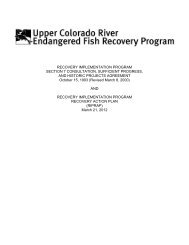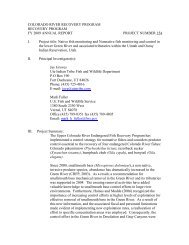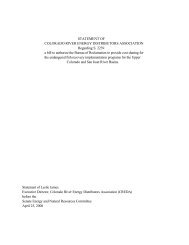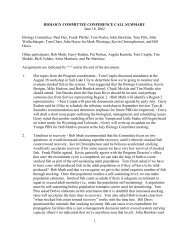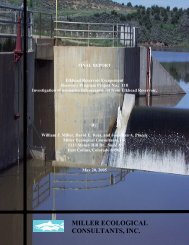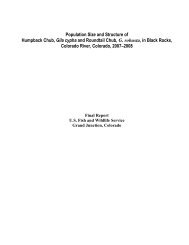K. R. Bestgen, K. A. Zelasko, and G. C. White. Monitoring ...
K. R. Bestgen, K. A. Zelasko, and G. C. White. Monitoring ...
K. R. Bestgen, K. A. Zelasko, and G. C. White. Monitoring ...
Create successful ePaper yourself
Turn your PDF publications into a flip-book with our unique Google optimized e-Paper software.
are spawning in the tributary itself. It is noteworthy that sampling in the San Rafael River<br />
confluence area produced some of the largest razorback sucker larvae captured from 1993–1999.<br />
Better information on distribution <strong>and</strong> abundance of larvae may assist with underst<strong>and</strong>ing<br />
reasons for the occasional larger age-0 or juvenile-sized razorback suckers found in that reach<br />
(Gutermuth et al. 1994, three 100+ mm fish captured in 2008, P. Badame pers. comm., Utah<br />
Division of Wildlife Resources).<br />
Colorado River Basin.—Adult razorback suckers have also been heavily stocked in the<br />
Gunnison <strong>and</strong> Colorado rivers, Utah <strong>and</strong> Colorado, beginning in 1994 (Burdick 2003;<br />
Osmundson <strong>and</strong> Seal 2009; <strong>Zelasko</strong> et al. 2011) but reproductive success has apparently been<br />
limited. Seine sampling from 2002–2007 in the lower 57 miles of the Gunnison River detected<br />
presence of nine positively identified razorback sucker larvae <strong>and</strong> 33 larvae identified as<br />
“razorback sucker?” (larvae whose taxonomic identity is slightly uncertain) among over 66,000<br />
fishes examined from 1,032 samples (Osmundson <strong>and</strong> Seal 2009). Razorback sucker larvae<br />
were captured from just downstream of Delta, Colorado, downstream to near the confluence with<br />
the Colorado River.<br />
Sampling in the Colorado River from 2004–2007 from upstream near Government<br />
Highline Canal downstream to Westwater, Utah, yielded 23 positively identified razorback<br />
sucker larvae <strong>and</strong> 1 larva identified as “razorback sucker?” among 26,000 fishes examined from<br />
670 samples. Razorback sucker larvae were widespread in samples in spite of low abundance<br />
(see Osmundson <strong>and</strong> Seal 2009 for details). Abundance of adult fish may be low; an estimated<br />
1,066 adult razorback suckers > 400 mm TL inhabited the Colorado River in 2005 in spite of<br />
stocking nearly 80,000 larger juvenile <strong>and</strong> adult fish through 2005 (Osmundson <strong>and</strong> Seal 2009,<br />
<strong>Zelasko</strong> et al. 2009; 2011). Ripe females, which may indicate locations of spawning adults, were<br />
distributed over a broad area from Fruita, Colorado, downstream to Moab, Utah. Low<br />
abundance of adults combined with widespread distribution may explain the widespread pattern<br />
of razorback sucker larvae.<br />
As was suggested by Ryden et al. (2011, Colorado-Gunnison River sampling scope of<br />
work, Recovery Program project 163), we support continued sampling of razorback sucker<br />
larvae in the Gunnison <strong>and</strong> Colorado rivers. Sampling needs to be widespread based on broad<br />
distribution of running ripe females <strong>and</strong> larvae detected in an earlier study (Osmundson <strong>and</strong> Seal<br />
2009) <strong>and</strong> should include light traps in appropriate locations including gravel pit ponds (e.g.<br />
Maggio Pond). Since samples <strong>and</strong> large numbers of all sucker larvae are easy to obtain but<br />
18




